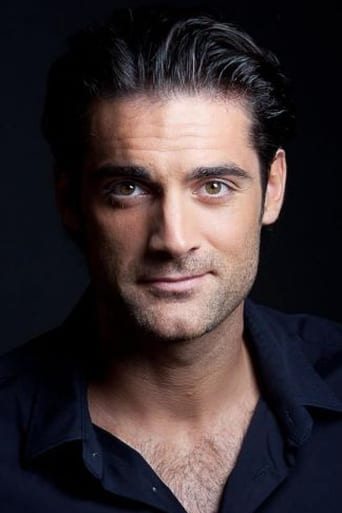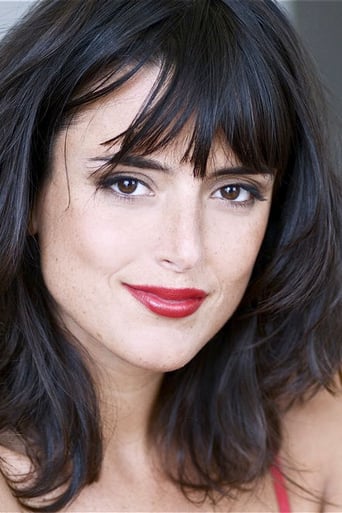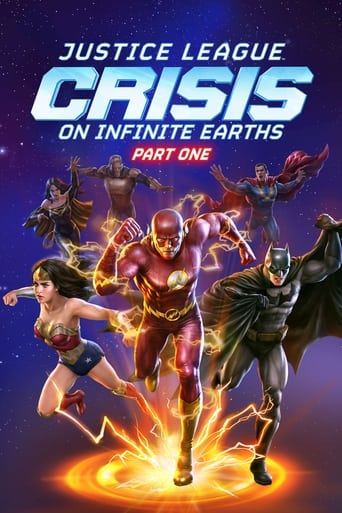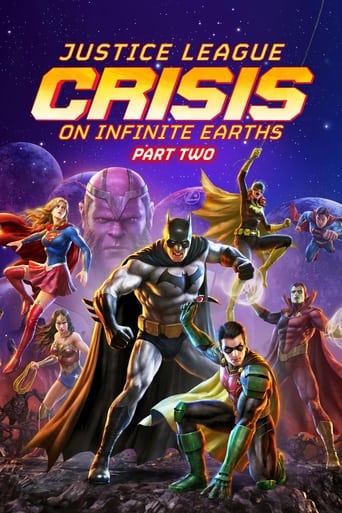FirstWitch
A movie that not only functions as a solid scarefest but a razor-sharp satire.
AshUnow
This is a small, humorous movie in some ways, but it has a huge heart. What a nice experience.
Arianna Moses
Let me be very fair here, this is not the best movie in my opinion. But, this movie is fun, it has purpose and is very enjoyable to watch.
Dana
An old-fashioned movie made with new-fashioned finesse.
jtfriday2000
Jacques (the other poster who gave this a 1-star rating) is right. There is no entertainment value in this film whatsoever. When I get into horror fiction, I don't need to see a blonde girl screaming her head off as she runs from some monster. What I look for in a good horror story is unsettling atmosphere and good characterization. I got neither in this film anthology.Look at the reviews for this film on the IMDb boards and they call this film "nauseatingly pretentious" and "artsy-fartsy". That's true. If you don't like pretentious or art-house films then do not waste your time with this anthology. The pacing in all these segments are slow. I don't think any of them are more than 15 minutes total but each felt three times longer.Too many times I watched these segments and was literally and figuratively left in the dark. I'd wonder, "What just happened?", skip back to see, and still would be lost. The stories lack any pull that entrances the viewer and makes him want to see more. I fell asleep during all 4 times I watched this movie. No lie.The makers of this movie forgot fear is an irrational emotion brought on by our own prejudices. As a result, we must emphasize emotionally with the characters and the situation they are in to be scared. But they tried to intellectualize fear--and did it in a way that came off as a tedious waste of time.I cannot recommend this movie to anyone, even art-house fans. This movie is a waste of time unless you desperately need something to cure insomnia. Just so you know, this movie is in black and white, but subtitled in white, which made it difficult to read at times. That did not bother me. It's just the plodding pacing, lack of characterizations, and inconclusive endings that bothered me.
newhealthrock
After seeing Fear(s) of The Dark I think I can safely say I was as, or more, affected than I have ever been after watching a film. Not since the horrific denouement of Haneke's original Funny Games do I think I have even come close to being as physically shook up as I was after seeing this film. A collaboration between six graphic artists and animators, I suppose if it must be distilled into the crudest possible collision of reference points it could be summarised as Stephen King meets Waking Life (Richard Linklater's 2001 film composed of rotoscope animation vignettes) yet that doesn't come anywhere close.The artists who have visualised nightmares for this project are Philadelphia native Charles Burns, ubiquitous to graphic novel fans due to his masterly disturbing book Black Hole; former Liquid Liquid bassist Richard McGuire; Belgian resident Marie Caillou; Christian Hinckler (better known by his pseudonym Blutch), and Italian Lorenzo Mattotti. Interspersing these animated tales are kaleidoscopic dancing patterns which are, through their hypnotic abstractions, perhaps the most visually mesmerising sequences in the whole film. These patterns are set to the vacuous middle-class fears and worries of a bourgeois woman, and the insubstantiality of her worries sets a theme which extends throughout the film. None of the fears represented in any of the narrative threads are viable. They are all tales of terror which one wouldn't have been surprised to find lurking in a battered Goosebumps paperback in the late nineties. This doesn't matter, though, because the film's power lies in its incredibly paced orchestrations of image and sound.After a joyously Gothic title sequence in which the film's name flashes on the screen at least five times (in a barrage of words reminiscent of Godard at his most poetically despotic) we are presented with an introduction to Blutch's storyline, which extends throughout the film. A hellish figure dressed in the clothes of a 18th century dandy roams a barren landscape with a pack of ferocious canines, hunting down unsuspecting victims and then proceeding to violently rip them apart (the last of which is a remarkably gory sequence). Ironically, considering the content of these scenes, Blutch's animation style is most reminiscent of either Raymond Briggs (In the constant shimmering of his charcoal textures) or the Walt Disney studios house style (In the fluidity of his characters' movements). Charles Burns and Lorenzo Mattotti present two sequences which are most reminiscent of scary bed-time stories, both being narrated in first-person. Visually, though, they couldn't be more different. Charles Burns' is, as you might imagine, the most like a moving graphic novel. The art is unmistakeably his, very clean-cut black lines without any grey, and the pictures tell the story of a conscientious student who embarks on a love affair with a girl which descends into an insectoid hell in a methodical, coherent style. Mattotti, on the other hand, tells the story of an eerie beast terrorising a small pastoral community in a free-and-easy sketchy style, with images that swim in and out of view like a dream.This is not the best representation of a bad dream within the film, though. That accolade goes to Marie Caillou, who presents to us an Oriental phantasm. A macabre inversion of a Studio Ghibli fantasy which gets more surreal as it proceeds, a young girl is tormented by dangers both real and imaginary. Not since The Mystery Man talked to Bill Pullman at the party in Lost Highway has a nightmare been so well orated on screen and it had a large majority of the audience locked in a collective terror. While Caillou's segment had an undeniable effect on the viewers, the last sequence, by Richard McGuire, is perhaps the most powerful of them all. Employing nothing but block black-and-white shapes to tell the story of a man who is haunted in a house by a mysterious woman, for the most part of his segment he eschews all non-diegetic music. The audience is thereby made extremely sensitive to every single movement made by the objects on screen and so the slightest motion, such as a hat-box dropping to the floor, causes the heart to skip a beat.
SandsofSamarkand
Peur(s) du Noir is essentially 5 short black and white animations interspersed by segments of a woman droning on about her fears, illustrated with interesting animated black and white shapes (I should note, I watched the film in French, and as my French is not perfect, I did not catch everything she said, but got the general impression that she was your typical anxious overachieving yuppie).The five shorts all used different animation techniques, but were overall pleasingly creepy. There was a cruel aristocrat and his dogs, an Italian village ravaged by a mysterious beast, a budding scientist and his insect specimens, a Japanese girl bullied by classmates/ghosts, and a refugee from a snowstorm shacked up in a Victorian house. This final short was, I thought, the most effective. It was done in pure black and white, and the only light shed in the house (with wonderfully Goreyesque wallpaper) came from a candle the traveller carried with him in his explorations. This allowed for some great reveal moments, and additionally built up the tension extremely well.Overall, a must see for fans of art-house animation. If it comes to a cinema near you, take the opportunity to see it, because I suspect it will be difficult to find on DVD.
ohm_intern
The story begins with what appears to be an old, sadistic British general walking a pack of angry dogs. A dog gets away and chases a small boy... thus beings one of a few stories of people's fears. The fears displayed in these animated segments usually involve an insect or animal beast. I think that the director either had a fascination or fear of bugs/animals.In between each segment, a soothing french voice tells us her "fears" but what I interpret as her observations and cristicms of society and social behaviors.One segment, a man is haunted by a praying mantis; in another, a girl is possessed by the ghost of a samuarai, in another.. a man has an encounter with the ghosts of an abandoned house.Each segment has a unique art style where people's bizarre fears become their lives. A great artistic representation of how people's fears can so easily become part of their reality - whether those fears are overcome or succombed to.







